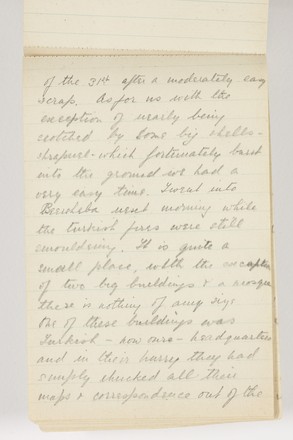
Maurice Evans 1917
MLMSS 1576/item 5
Manuscript

MLMSS 1576/item 5
Manuscript
Horses usually need to consume around 30 litres of water a day. During the Middle East campaign they often went up to 60 hours without water while carrying a load of almost 130 kilograms, comprising rider, saddle, equipment, food and water.
In early 1916, Evan’s was deployed to protect the Nile valley from pro-Turkish Senussi Arabs.
At the end of World War I, the AIF had 13,000 surplus horses that for quarantine reasons could not be returned home. Of these13,000, 11,000 were sold to the British Army for use in India. The remaining 2000 old and sick horses were shot.
In May 1916, Evans’ regiment joined the Allied forces defending the Suez Canal.
The famous last charge of the Light Horsemen at the Battle of Beersheba took place at 4.30 pm on 31 October 1917. It was the last charge by mounted troops in modern warfare.
Throughout the diary, Evans writes about affectionately, his horse, Bernard.
Eight hundred soldiers took part in the last charge of the Light Horsemen.
135,926 horses were shipped from Australia to Egypt, India, Britain and France for service in the war. They had been purchased for £20 per head.
The type of horse used by the Light Horse was called a Waler.